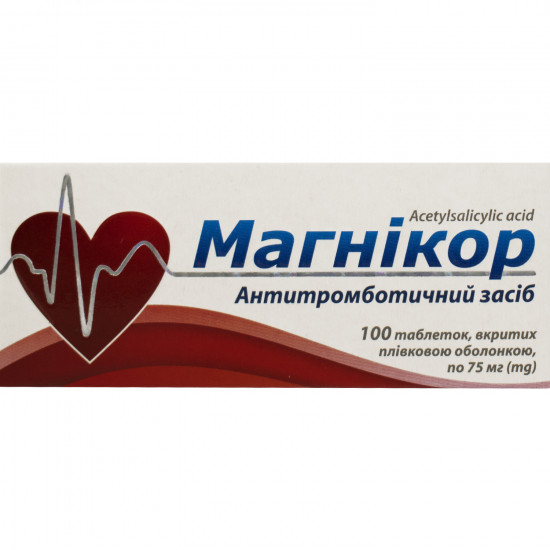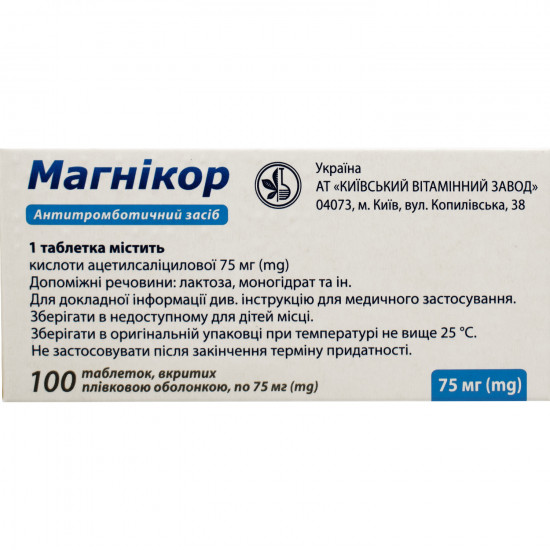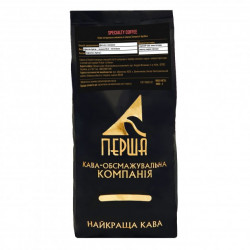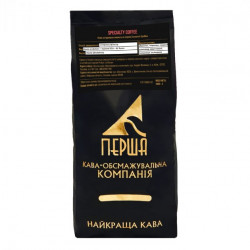



- Stock: In Stock
- Model: 182023
0% Customers recommend this product
-
5 Awesome0%
-
4 Great0%
-
3 Average0%
-
2 Bad0%
-
1 Poor0%
Reviews Over Magnikor of the tab. of p/o No. 100
- (0)
Total Reviews (0)
click here write review to add review for this product.
Report this review.
Description
Pharmacological properties
Pharmacodynamics. acetylsalicylic acid — analgetic, anti-inflammatory, febrifugal and antiagregantny drug. antiagregantny properties increase a bleeding time.
Main pharmacological effect — inhibition of synthesis of prostaglandins and thromboxanes. The analgesic effect is additional and is caused by COG enzyme inhibition. The anti-inflammatory effect is connected with the reduced blood-groove which is caused by inhibition of synthesis of PGE 2 .
Acetylsalicylic acid it is irreversible inhibits synthesis of G/H prostaglandins, its influence on prostaglandins lasts longer, than acetylsalicylic acid is in an organism. Influence of acetylsalicylic acid on biosynthesis of thromboxane in thrombocytes and for a bleeding time continues is long after the therapy termination. It is terminated only after emergence of new thrombocytes in blood plasma.
Salicylic acid (active metabolite of acetylsalicylic acid) has anti-inflammatory effect and also influences breath processes, a condition of acid-base balance and a mucous membrane of a stomach. Salicylates stimulate breath, mainly carrying out direct impact on marrow. Salicylates carry out indirect influence on a mucous membrane of a stomach by inhibition of its vazodilatatorny and cytoprotective prostaglandins and increase risk of developing of ulcers.
Magnesium hydroxide renders toantiacid effect and protects a mucous membrane of a food path from the irritating influence of acetylsalicylic acid.
Pharmacokinetics
Absorption. After intake, acetylsalicylic acid is quickly soaked up in a GIT. After intake the absorption of not ionized form of acetylsalicylic acid happens in a stomach and intestines. Speed of absorption decreases after meal and patients with attacks have migraines, raises — at patients with an achlorhydria or at the persons applying polysorbates or antacids. With max in blood plasma it is reached
magnesium in small amounts slowly is absorbed byAt oral administration through 1–2 h in a small intestine.
Distribution. Linking of acetylsalicylic acid with proteins of blood plasma makes 80–90%. Distribution volume for adults is 170 ml/kg of body weight. Salicylates contact proteins of blood plasma and quickly spread on an organism. Salicylates get into breast milk and can get through a placental barrier. Magnesium spreads with proteins in the connected look (about 25-30%). A small amount gets into breast milk. Magnesium can pass through a placental barrier.
Metabolism. Acetylsalicylic acid is hydrolyzed to an active metabolite — salicylate — in a stomach wall. After absorption, acetylsalicylic acid quickly turns into salicylic acid, but within the first 20 min. after intake dominates in blood plasma.
Removal. Salicylate is removed mainly due to hepatic metabolism. Thus, equilibrium concentration of salicylic acid in blood plasma increases to the dose which is disproportionately accepted inside. In a dose of 325 mg of acetylsalicylic acid the removal happens to participation of kinetics of reaction of the first order. The t ½ makes 2–3 h. At a high dose of acetylsalicylic acid T ½ increases to 15–30 h. Salicylate is also removed in an invariable view with urine. The removed volume depends on the level of a dose and rn urine. About 30% of a dose are removed with urine if urine reaction alkaline, only 2% — if acid. Discharge kidneys occurs thanks to processes of glomerular filtration, active secretion of renal tubules and a passive tubular reabsorption. A small amount of magnesium is removed with urine, but the most part reabsorbirutsya and removed with a stake.
Indication
- Sharp and chronic ischemic heart disease. prevention of a repeated thrombogenesis. primary prevention of thromboses, cardiovascular diseases, such as sharp coronary syndrome at patients is aged more senior than 50 years at which note risk factors of developing diseases of a cardiovascular system: ag, a hypercholesterolemia, diabetes, obesity (body mass index 30), the hereditary anamnesis (a myocardial infarction at least at one of parents, the brother or the sister at patients aged up to 55 years).
Tablet swallow of
whole, if necessary washing down with water. if desired the tablet can be pulled down in half, to chew or previously to pound. Course of treatment the doctor defines
individually, depending on indications and disease severity.
Sharp and chronic ischemic heart disease
Recommended initial dose — 150 mg/days. A maintenance dose — 75 mg/days
Acute myocardial infarction. Unstable stenocardia
Recommended dose makes 150–450 mg, apply as soon as possible after emergence of symptoms.
Prevention of a repeated thrombogenesis
Recommended initial dose — 150 mg/days. The maintenance dose — 75 mg/days
Primary prevention of thromboses, cardiovascular diseases, such as sharp coronary syndrome, at patients with factors is development of cardiovascular diseases
Recommended preventive dose — 75 mg/days
Contraindication
- Hypersensitivity to acetylsalicylic acid, other salicylates or any component of drug. oh, caused by intake of salicylates or substances with similar action, especially npvp in the anamnesis. acute round ulcer. hemorrhagic diathesis. renal failure of heavy degree. liver failure of heavy degree. heart failure of heavy degree. a combination with a methotrexate in a dose of ≥15 mg/week (see interactions).
Side effects
from a GIT: frequent manifestations and symptoms of dyspepsia, pain in epigastric area and abdominal pain in some cases — inflammation of a GIT, GIT erosive cankers which can lead in rare instances to a gastrointestinal hemorrhage and perforation with the corresponding laboratory indicators and clinical manifestations.
Owing to antiagregantny action on thrombocytes acetylsalicylic acid can be associated with risk of developing bleedings, lengthening of a bleeding time. Such bleedings as post-operational hemorrhages, hematomas, bleedings from bodies of an urinogenital system, nasal bleedings, odontorrhagias were observed; seldom or very seldom — serious bleedings, such as GIT hemorrhage, cerebral hemorrhage (especially at patients with uncontrollable hypertensia and/or at simultaneous use of anti-hemostatics) which in rare instances could threaten life potentially.
Hemorrhage can be led to acute and chronic posthemorrhagic anemia / an iron deficiency anemia (owing to the so-called latent microbleeding) with the corresponding laboratory manifestations and clinical symptoms, such as asthenia, pallor of integuments, hypoperfusion.
byAt patients with severe forms of insufficiency glyukozo-6-fosfatdegidrogenazy observed hemolysis and hemolytic anemia.
toIt was reported about a renal failure and development of OPN.
Hypersensitivity reaction with the corresponding laboratory and clinical manifestations, including an asthmatic state, skin reactions of easy or average degree and also from a respiratory path, a GIT and a cardiovascular system, including such symptoms as rash, urticaria, hypostasis, an itching, rhinitis, congestion of a nose, cardiorespiratory insufficiency and it is very rare — heavy reactions, including an acute anaphylaxis.
toit was Very seldom reported about a tranzitorny liver failure with increase in level of transaminases and SF in blood plasma.
were Noted by dizziness and a ring in ears that it can demonstrate overdose.
Special instructionsMedicine a magnikor to apply
with care in the following situations: - hypersensitivity to analgetic, anti-inflammatory, antirheumatic medicaments and also in the presence of an allergy to other substances;
- a GIT ulcer, including a chronic and recurrent ulcer or gastrointestinal bleedings in the anamnesis;
- simultaneous use of anticoagulants;
- at patients with renal failures or persons with disturbances of cardiovascular blood circulation (for example pathology of vessels of a kidney, stagnant heart failure, a hypovolemia, extensive operations, sepsis or severe bleedings) as acetylsalicylic acid can increase risk of a renal failure and OPN also;
- with heavy insufficiency glyukozo-6-fosfatdegidrogenazy acetylsalicylic acid can cause hemolysis or hemolytic anemia in patients. Especially in the presence of factors which can increase risk of hemolysis, for example medicine in high doses, fever or acute infectious process, an abnormal liver function.
Ibuprofen can reduce inhibitory effect of acetylsalicylic acid on aggregation of thrombocytes. In case of use of Magnikor medicine before use of an ibuprofen as anesthetic the patient has to consult with the doctor.
Acetylsalicylic acid can cause development of a bronchospasm or attack OH or other hypersensitivity reactions. Risk factors include OH in the anamnesis, hay fever, polyposes of a nose or a chronic respiratory disease, allergic reactions (for example skin reactions, an itching, urticaria) on other substances in the anamnesis.
Because of inhibitory effect of acetylsalicylic acid on aggregation of thrombocytes which remains within several days after use the intake of the medicines containing acetylsalicylic acid can increase probability/strengthening of bleeding at surgeries (including insignificant surgical interventions, for example odontectomy).
At use of acetylsalicylic acid in low doses the removal of uric acid can decrease. It can lead to a gout attack at predisposed patients.
should not apply the medicines containing acetylsalicylic acid, to children and teenagers with a SARS which is followed or is not followed by fervescence, without consultation with the doctor. In some viral diseases, especially in flu A, flu B and chicken pox, there is a risk of development of a syndrome of Ray which is very rare, but life-threatening disease, demands urgent medical intervention. The risk can be raised if to apply acetylsalicylic acid as the accompanying medicine, however relationship of cause and effect in this case is not proved. If the specified states are followed by constant vomiting, it can be manifestation of a syndrome of Ray.
Use during pregnancy and feeding by a breast. Suppression of synthesis of prostaglandins can negatively influence pregnancy and/or embryonic/pre-natal development. The available data of epidemiological researches indicate risk of an abortion and malformations of a fruit after use of inhibitors of synthesis of prostaglandins at the beginning of pregnancy. The risk increases depending on increase in a dose and duration of therapy. According to the available data, communication between use of acetylsalicylic acid and the increased risk of an abortion is not confirmed.
Available epidemiological data on developing of malformations are not consecutive, however the increased risk of a gastroshizis cannot be excluded at use of acetylsalicylic acid. The available data concerning consequences in early pregnancy (1-4th month) do not indicate any communication with the increased risk of development of malformation.
Research on animals is pointed out reproductive toxicity.
B I and the II trimester of pregnancy should not appoint the medicines containing acetylsalicylic acid without accurate clinical need. For women who can probably be pregnant women or in I and II trimester of pregnancy the dose of the medicines containing acetylsalicylic acid has to be as low as possible, and treatment duration — as it is possible well.
In the III trimester of pregnancy all inhibitors of synthesis of prostaglandins can influence a fruit as follows:
- cardiopulmonary toxicity (with premature closing of an arterial channel and pulmonary hypertensia);
- a renal failure with possible subsequent development of a renal failure with oligogidramniony.
at the end of pregnancy inhibitors of synthesis of prostaglandins can influence the woman and the child as follows:
- a possibility of extension of a bleeding time, antiagregantny effect which can arise even after use of medicament in very low doses;
- slowing down of reductions of a uterus that can lead to a delay or increase in a duration of delivery.
Despite this, acetylsalicylic acid is contraindicated in the III trimester of pregnancy.
Salicylates and their metabolites get into breast milk in small amounts.
As did not reveal an adverse effect of medicine on the child after use for women during feeding by a breast, it is not required to interrupt feeding with a breast, as a rule. However in cases of regular use or at use in high doses the breastfeeding needs to be stopped at early stages.
Children. According to indications (see USE) Magnikor medicine is not applied at children.
Use of acetylsalicylic acid for children aged up to 15 years can cause heavy side effects (including Ray's syndrome, one of signs of which is constant vomiting).
Ability to influence speed of response at control of vehicles or work with other mechanisms. Does not influence.
Interaction
Contraindication for simultaneous use
Methotrexate. Use of acetylsalicylic acid and a methotrexate in a dose of ≥15 mg/week increases hematologic toxicity of a methotrexate (decrease in renal clearance of a methotrexate by anti-inflammatory agents and replacement by methotrexate salicylates from communication with proteins of blood plasma).
APF Inhibitors. APF inhibitors in a combination with acetylsalicylic acid in high doses cause decrease in filtration in balls owing to inhibition of vazodilatatorny effect of prostaglandins and decrease in antihypertensive effect.
Acetazoleamide. Increase in concentration of acetazoleamide can lead to penetration of salicylates from blood plasma in body tissue and cause toxicity of acetazoleamide (fatigue, slackness, drowsiness, confusion of consciousness, a giperkhloremichesky metabolic acidosis) and toxicity of salicylates (vomiting, tachycardia, a hyperpnea, confusion of consciousness).
Probenetsid, Sulfinpyrazonum. At use of a probenetsid and salicylates in high doses (500 mg) the metabolism of both medicines is suppressed and excretion of uric acid can decrease.
Combination which should be applied with care
Methotrexate. At use of acetylsalicylic acid and a methotrexate in doses of 15 mg/week the hematologic toxicity of a methotrexate increases (decrease in renal clearance of a methotrexate by anti-inflammatory agents and replacement by methotrexate salicylates from communication with blood plasma proteins).
Klopidogrel, tiklopidin. The combined use of a klopidogrel and acetylsalicylic acid renders synergy effect. Such combined use should be carried out with care as it increases risk of developing of bleeding.
Anticoagulants (warfarin, fenprokumon). Reduction of products of thrombin is possible therefore indirect influence on decrease of the activity of thrombocytes (antagonist of vitamin K) is carried out and the risk of developing of bleedings increases.
Abtsiksimab, tirofiban, eptifibatid. The inhibition a glycoprotein of IIb/IIIa-receptors on thrombocytes is possible that leads to increase in risk of developing of bleedings.
Heparin. Reduction of producing thrombin is possible therefore indirect influence on decrease of the activity of thrombocytes is carried out that leads to increase in risk of developing of bleeding.
If two or more of the above-stated substances to applytogether with acetylsalicylic acid, it can result in synergy enhancement effect of inhibition of activity of thrombocytes and as result, to strengthening of hemorrhagic diathesis.
NPVP and TsOG-2 inhibitors (tselekoksib). Simultaneous use increases risk of emergence of gastrointestinal disturbances that can lead to gastrointestinal bleedings.
Ibuprofen. The combined use of an ibuprofen inhibits the irreversible aggregation of thrombocytes caused by effect of acetylsalicylic acid. Treatment by an ibuprofen at patients with the increased risk of impact on a cardiovascular system can limit cardiotyre-tread effect of acetylsalicylic acid.
Patients applying acetylsalicylic acid of 1 times a day for the purpose of prevention of cardiovascular diseases and from time to time applying an ibuprofen, have to apply acetylsalicylic acid at least for 2 h before use of an ibuprofen.
Furosemide. The inhibition of proximal canalicular elimination of furosemide is possible that leads to decrease in diuretic effect of furosemide.
Quinidine. Perhaps additive influence on thrombocytes that leads to increase in a bleeding time.
Spironolactonum. The modified effect of renin is possible that it leads to decrease in efficiency of Spironolactonum.
Selective serotonin reuptake inhibitors. The combined use increases risk of emergence of gastrointestinal disturbances that can lead to gastrointestinal bleeding.
Valproatum. At simultaneous use with Valproatum acetylsalicylic acid forces out it from communication with proteins of blood plasma, increasing toxicity of the last (oppression of central nervous system, GIT).
System GKS (excepting a hydrocortisone which is applied to replacement therapy in Addison's disease) reduce the level of salicylates in blood and increase risk of overdose after the end of treatment.
Antidiabetic medicines. Simultaneous use of acetylsalicylic acid and antidiabetic medicines increases risk of emergence of a hypoglycemia.
Antacids. Increase in renal clearance and decrease in renal absorption is possible (in connection with increase rn urine) that leads to decrease in effect of acetylsalicylic acid. Clinical value of interaction of acetylsalicylic acid and magnesium minimum due to a small amount of magnesium which is a part of medicine.
Vaktsin'sagainst chicken pox. The combined use increases risk of development of a syndrome of Ray.
Ginkgo of a bilob. The combined use with a ginkgo of a bilob interferes with aggregation of thrombocytes that leads to increase in risk of bleedings.
Digoksin. At simultaneous use with digoxin the concentration of the last in blood plasma increases owing to decrease in renal excretion.
Alcohol promotes injury of a mucous membrane of a GIT and prolongs a bleeding time owing to synergism of acetylsalicylic acid and alcohol.
Overdose
Toxicity
Toxic dose. Adults: 300 mg/kg of body weight.
Chronic poisoning with salicylates can have the hidden character as signs and symptoms its nonspecific. The moderate chronic intoxication caused by salicylates or a salitsilizm, is noted, as a rule, only after repeated uses in high doses.
Symptoms. Symptoms of chronic poisoning of average degree (result of prolonged use of medicine in high doses): dizziness, deafness, the increased sweating, fever, rapid breathing, sonitus, a respiratory alkalosis, a metabolic acidosis, slackness, moderate dehydration, a headache, confusion of consciousness, nausea and vomiting.
significant change of acid-base balance which can differ depending on age and weight of intoxication testifies To acute intoxication. Its frequent manifestation at children is the metabolic acidosis. Weight of a state cannot be estimated only on the basis of data on concentration of salicylates in blood plasma. Absorption of acetylsalicylic acid can slow down in connection with a delay of release of a stomach, forming of concrements in a stomach or in case of its use in the form of the tablets covered with an enterosoluble cover.
Symptoms of serious and acute poisoning (owing to overdose): a hypoglycemia (mainly at children), encephalopathy, a coma, hypotension, a fluid lungs, spasms, a coagulopathy, brain hypostasis, disturbance of a warm rhythm.
More significant toxic effect is observed byat patients with chronic overdose or abuse of medicine and also at elderly people or children.
Treatment. In case of acute overdose the gastric lavage and use of activated carbon is necessary. At suspicion on the use of a dose of 120 mg/kg of body weight it is necessary to apply activated carbon repeatedly.
salicylate Level should be measured byin blood plasma at least each 2 h after use of a dose until the level of salicylate is reduced and restored acid-base balance.
Prothrombin time and/or INI (the international normalized index) have to be checked by, in particular, at suspicion of bleeding.
needs to restore balance of liquid and electrolytes. Effective methods of removal of salicylate from blood plasma is the alkaline diuresis and a hemodialysis. The hemodialysis should be applied in case of heavy intoxication as this method considerably accelerates removal of salicylates and restores acid-base and water-salt balances.
and symptoms/results of analyses can includeBecause of complex pathophysiological effects of poisoning with salicylates of manifestation:
| Manifestation and symptoms | Results of analyses | Therapeutic actions |
|---|---|---|
| Intoxication of easy or average degree | Gastric lavage, repeated administration of activated carbon, the forced alkaline diuresis | |
| Tachypnea, a hyperventilation, a respiratory alkalosis | Alkalemiya's, an alkaluria | Recovery of electrolytic and acid-base balance |
| Hyperhidrosis (the increased sweating) | ||
| Nausea, vomiting | ||
| Intoxication of average or heavy degree | Gastric lavage, repeated administration of activated carbon, the forced alkaline diuresis, a hemodialysis in hard cases | |
| Respiratory alkalosis with a compensatory metabolic acidosis | Acidemia, an aciduria | Recovery of electrolytic and acid-base balance |
| Giperpireksiya | Recovery of electrolytic and acid-base balance | |
| Respiratory: hyperventilation, not cardiogenic fluid lungs, respiratory insufficiency, asphyxia | ||
| Cardiovascular: a dizaritmiya, arterial hypotension, cardiovascular insufficiency | Change of the ABP, the ECG | |
| Loss of liquid and electrolytes dehydration, an oliguria, a renal failure | Hypopotassemia, a hypernatremia, a hyponatremia, changes of kidneys | Recovery of electrolytic and acid-base balance |
| glucose metabolism Disturbance, ketoacidosis | Hyperglycemia, a hypoglycemia (especially at children). increased level of ketone bodies | |
| Ring in ears, deafness | ||
| Gastrointestinal: bleeding in a GIT | ||
| Hematologic: inhibition of thrombocytes, coagulopathy | Prolongation of PT, prothrombinopenia | |
| Neurologic: toxic encephalopathy and oppression of central nervous system with such manifestations as a lethargy, confusion of consciousness, a lump and a spasm | ||
Storage conditions
In original packing at a temperature not above 25 °C.
Translation of the instruction Mose
Specifications
| Characteristics | |
| Active ingredients | Acetylsalicylic acid |
| Applicant | Kiev vitamin plant |
| Code of automatic telephone exchange | B01AC06 acetylsalicylic acid |
| Interaction with food | It doesn't matter |
| Light sensitivity | Not sensitive |
| Market status | Traditional |
| Origin | Chemical |
| Prescription status | According to the prescription |
| Primary packing | blister |
| Producer | KIEV VITAMIN PLANT OF THE JOINT-STOCK COMPANY |
| Quantity in packing | 100 tablets (10 blisters on 10 pieces) |
| Release form | tablets for internal use |
| Route of administration | Oral |
| Sign | Domestic |
| Storage temperature | from 5 °C to 25 °C |
| Trade name | Magnikor |




















